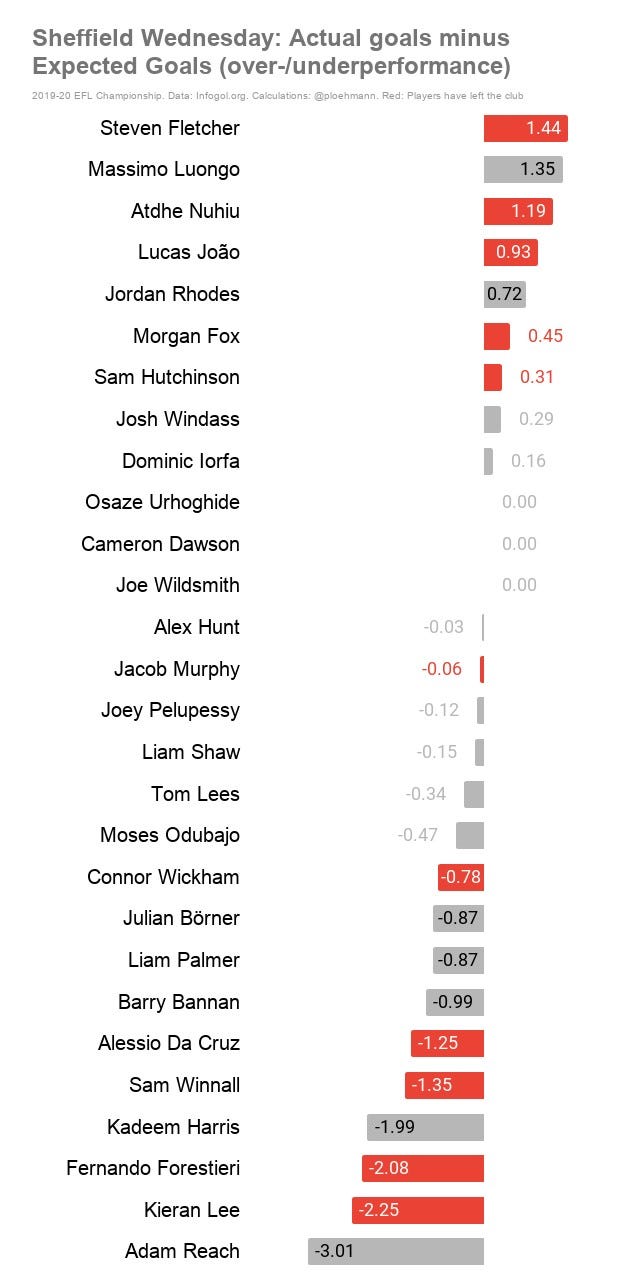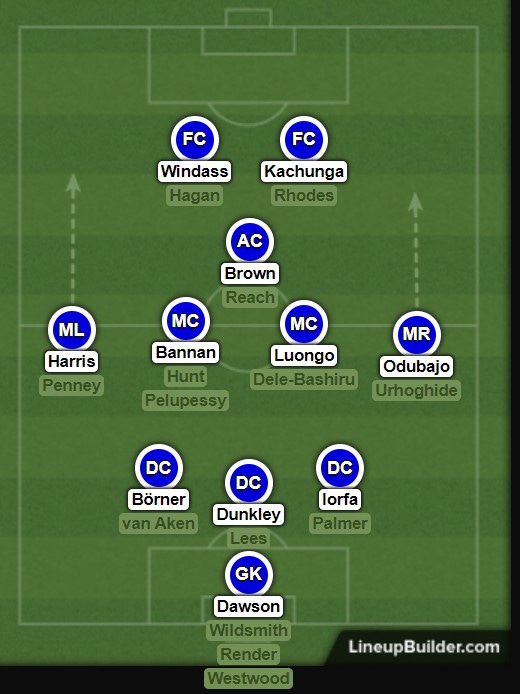Sheffield Wednesday 2020-21: Trying to make a molehill out of a mountain
Garry Monk will be trying to make a molehill out of the -12 points mountain currently towering in front of a Sheffield Wednesday that is finally beginning to look like his with a new-look team of coaches and assistants for the first team and 5 new players, 4 of them permanent signings.
The core reason for that points deduction - spending beyond the limits agreed upon in the Championship - has been weighing Wednesday down in recent seasons. An astonishing amount of money has been squandered since Dejphon Chansiri became the legal owner of the club, but the purse strings have been tightened in recent years: The wage bill has been pretty much halved in three seasons and is now back to the level it was in Chansiri’s first season, 2015-16:

In addition to slashing the wage bill, of the £37m in transfer fees spent since 2015, only £2.2m has been paid in transfer fees since January 2018.
It has made the squad a lot more healthy financially, as indicated below, where the signings in red are those from 2015-2017, those in yellow are from before that and those in green are players signed since 2018:

Why start a season preview with finances? Well, this season will - at best - be a transitional season and - at worst - a scrap against relegation. The result of the season, then, won’t just be the final position, but also the foundations laid for future seasons by greatly lowering player costs and investing playing minutes in younger players developing.
Clearing out costs and underperforming players also means, however, that Wednesday have had to replace (all excluding penalties):
- a third of the minutes played in 2019-20,
- 30 of 51 goals (60%)
- 33.6 of 59 Expected Goals (57%)
- 26 of 40 big chances (65%)
- 17 of 45 Expected Assists (38%)

Quite a few of those that have left were also overperforming their Expected Goals:

And Wednesday were already struggling to convert goals last season, being the most profligate from open play in the division last season:

Wednesday would’ve scored 11 more goals from open play - 44 instead of 33 - if their finishing had been just average last season. Being joint 7th in the creation of and scoring from set-pieces suggests that is not where the problem lies.
The lack of goals puts an onus on a defence that was good at restricting the opposition shots (only Leeds and Brentford conceded fewer shots from open play than Wednesday), but only Barnsley and Stoke conceded a higher Expected Goals per shot.
Another issue has been the lack of established attacking play, which was slightly papered over by Wednesday’s ability to pounce on mistakes. Only rabid pressers Barnsley (49) - and promoted West Bromwich (48) - created more shots than Wednesday from situations where the ball was turned over (46), and only Bristol City (6) scored more than Wednesday (5) from those situations.
Wednesday conceded more goals (18, 27% of goals conceded) after the 80th minute than any other Championship team, and only Stoke and Wigan managed to equalise an opponent’s lead less often than Wednesday last season. Perhaps a reflection of the lack of mental and physical stamina in a team that had the second-highest average age of its starting line-ups at 27.4?
Finally, opponents particularly overperformed in front of goal in the dying stages of matches:

Wednesday managed to salvage just 8 points from the 21 matches where the opponents scored first, and only three teams took the lead less often at home than Wednesday, while Wednesday also had the third-lowest points won per game they scored first in (2). All of which further underscores the issues with competing for 90 minutes, especially mentally. Monk also lamented lapses of concentration and personal errors quite often in post-match press conferences throughout last season.
In half of the previous 22 seasons the team finishing just outside relegation in 21st have won between 48 and 50 points:

Wednesday’s survival target, then, is 50 + 12 = 62 points, which is about as mid-table a form as you can get: If Wednesday win one, draw one and lose one out of every three matches this season safety is likely to be secured.
Before the restart, after the COVID-break Garry Monk changed the setup of the team to a 3-5-2 formation that becomes more of a 3-3-4 in attack as both wingbacks - Harris and loanee Jacob Murphy during July - were very attack-minded.
Monk has stuck with that formation, which is, curiously, also the formation Jos Luhukay plumped for when he first arrived. It gives a much larger degree of defensive solidity with the three centrebacks, but it is also a formation that often goes stale unless players are active off the ball and create the space required.
To that end the signing of Izzy Brown is key. No regular last season created chances at a higher rate than Brown (one key pass every 28 minutes) and that in a promoted Luton Town side struggling for much of the season.
Opponents too often last season managed to neutralise Wednesday by either packing themselves deep and denying space around their defence - space Wednesday were unable to create themselves for large parts - or by pressing Wednesday high to gain dominance of the midfield area and push Bannan far back into a “quarterback pocket”.
Brown is more an enabler than a finisher, but Wednesday are desperate for more goals from midfield. Bannan, Luongo and Reach scored just 6 goals between them last season despite 7,660 minutes of playing time (roughly 85 full matches).

In the Carabao Cup first-round match at Walsall we saw the first steps on the road to that perhaps changing: With three instead of two centrebacks, the need to “screen” defence with a designated defensive midfielder is less of a requirement. That allows a more fluid central midfield and there were promising signs of an understanding developing between Bannan and Izzy Brown precisely because Bannan played further forward than he did for large parts of last season.
We know Bannan has all the ability needed to be dangerous from the edge of the box and hopefully with the opposition less sure of how to stifle us - sticking an extra man on Bannan and Harris will no longer work - Bannan, Brown and Luongo will get plenty of opportunities.
A significant chunk of Wednesday’s albeit few chances and openings on that day right next to the M6 also came from quickly switching sides - often facilitated by Brown - to the wing-backs trying to go round defences or get an early cross in.
We’re obviously still screaming out for (a) Steven Fletcher to spearhead the attack and make attacks click into a higher gear and that will remain the highest priority before the domestic transfer window slams shut on October 16.
Another source of goals that could make us less reliant on having a “20 goals a season striker” (a mythical beast more than actual animal actually: https://www.playmakerstats.com/news.php?id=271843) is set pieces.
Dominic Iorfa has publicly said he missed his target of 5 goals last season - he got 2 - and Chey Dunkley has come in as the centreback with the highest scoring rate - a goal every 3-4 matches - among centrebacks in last season’s Championship and a total of 6 goals scored for Wigan.
If Börner and/or Lees can add to the 1 and 2 goals they scored last season respectively it would, all in all, remove some of the pressure on a front two to do it all for us goal wise.
If centrebacks can chip in with a combined 15 goals, and Bannan, Luongo and Brown can do similar, we’d likely “just” need 30-35 goals from the two wingbacks and two forward positions to comfortably survive.
Harris should get more space to threaten, especially if he cuts inside and drives into the box shooting with his right more rather than his well-worn step-over and cross from the byline act.
Just like there’s a Steven Fletcher-sized hole upfront, there’s also a Jacob Murphy-sized hole at right wingback, a position the Newcastle loanee took to with a flourish after the COVID-restart in July. Next to a no. 9 that is probably Monk’s priority for reinforcements in the remainder of this transfer window.
Lining up in a 3-5-2, then, Wednesday’s squad at the time of writing (September 7) looks as follows:

Sources:
www.Infogol.net (manually entered Expected Goals values for all shots in Wednesday’s 2019-20 matches)
www.statsbomb.com (2019-20 season review, Expected Goals at team level)
www.football-data.co.uk (goals, leads, scoring time, first scorer)
www.transfermarkt.co.uk (average age of line-ups)
www.worldfootball.net (historical performance of teams in positions)
www.whoscored.com (player statistics)



